The Commercial Truck Market is estimated to be valued at USD 85.0 billion in 2025 and is projected to reach USD 167.2 billion by 2035, registering a compound annual growth rate (CAGR) of 7.0% over the forecast period. The commercial truck market is projected to grow from USD 85.0 billion in 2025 to USD 167.2 billion by 2035, reflecting a CAGR of 7.0%. Inflection point mapping reveals key phases of acceleration and stabilization in the market’s growth. From 2025 to 2029, the market experiences steady growth, moving from USD 60.6 billion to USD 85.0 billion. This early phase reflects gradual increases driven by ongoing demand for commercial trucks in transportation, logistics, and e-commerce, which continue to expand as industries seek efficient and reliable delivery solutions. Between 2029 and 2031, the market hits an inflection point, with growth accelerating from USD 91.0 billion to USD 97.3 billion.
This acceleration is primarily attributed to the increasing adoption of electric trucks, advancements in autonomous vehicle technology, and the expansion of infrastructure to support commercial trucking operations. This period marks a transition to a higher growth trajectory, with market players focusing on cost-efficiency. From 2031 to 2035, the market continues to expand at a more robust pace, reaching USD 167.2 billion by 2035. This stage reflects further adoption of electric and smart commercial vehicles, coupled with greater investments in supply chain optimization and environmental regulations. The inflection points between 2029 and 2031 are critical in shaping the market’s long-term growth trajectory, as innovation and new technologies become more mainstream.
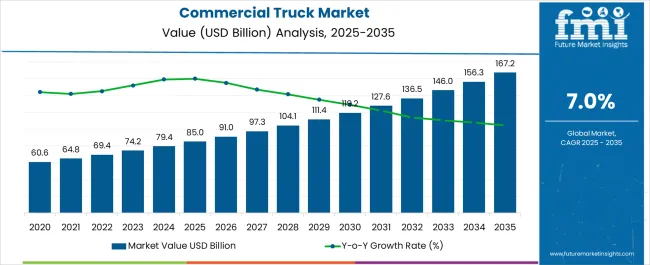
| Metric | Value |
|---|---|
| Commercial Truck Market Estimated Value in (2025 E) | USD 85.0 billion |
| Commercial Truck Market Forecast Value in (2035 F) | USD 167.2 billion |
| Forecast CAGR (2025 to 2035) | 7.0% |
The commercial truck market is experiencing consistent growth driven by global expansion in logistics, infrastructure development, and rising demand for last mile delivery solutions. Rapid industrialization, growth in construction activity, and e commerce penetration have created sustained demand for medium and heavy duty vehicles with robust payload capacities.
Fleet operators are prioritizing fuel efficiency, emission compliance, and advanced safety features, prompting manufacturers to invest in next generation drivetrains, lightweight materials, and intelligent telematics. Urbanization trends and regional trade agreements are also facilitating vehicle deployment across domestic and cross border routes.
The outlook for the market remains optimistic as freight volumes grow and technological innovation continues to reshape vehicle design and operational efficiency across commercial transportation networks.
The commercial truck market is segmented by fuel, class, application, ownership, and geographic regions. By fuel, the commercial truck market is divided into Diesel, Natural gas, and Hybrid electric. In terms of class, the commercial truck market is categorized into Classes 1, 2, 3, 4, 5, 6, 7, and 8. Based on application, the commercial truck market is segmented into Freight delivery, Utility services, Construction & mining, and Others. By ownership, the commercial truck market is segmented into Fleet operators and Owner operators. Regionally, the commercial truck industry is classified into North America, Latin America, Western Europe, Eastern Europe, Balkan & Baltic Countries, Russia & Belarus, Central Asia, East Asia, South Asia & Pacific, and the Middle East & Africa.
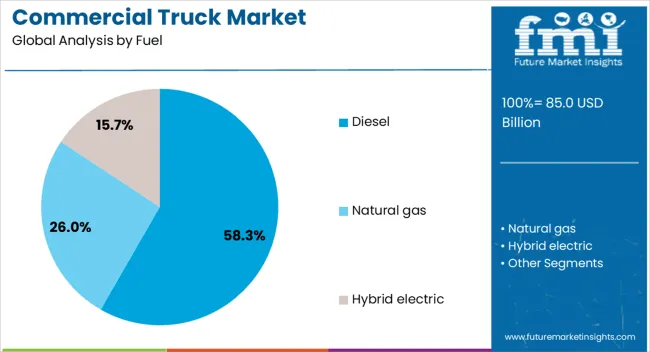
The diesel segment is projected to account for 58.30% of total market revenue by 2025 under the fuel category, making it the most dominant segment. This leadership position is attributed to diesel engines offering superior torque, fuel economy, and longevity which are essential in long haul and high payload operations.
Diesel powered trucks remain the preferred choice for fleet operators due to their proven reliability in varied terrains and cost effectiveness over extended duty cycles.
Despite the rise of alternative fuel options, infrastructure availability, refueling convenience, and engine durability continue to support the dominance of diesel powered commercial vehicles in key markets worldwide.
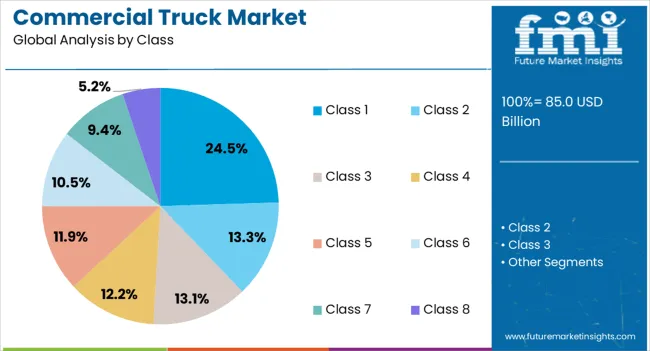
The class 1 segment is expected to contribute 24.50% of overall market revenue by 2025 within the vehicle class category. This growth is being driven by increasing demand for light commercial trucks used in urban and suburban freight movement, service delivery, and retail logistics.
Class 1 trucks offer ease of maneuverability, lower emissions, and cost efficiency, which make them ideal for intra-city operations. Additionally, rising adoption among small and medium enterprises and the integration of electric models in this class are strengthening its market footprint.
Regulatory incentives and growing interest in compact utility vehicles further support the class 1 segment’s expanding share.
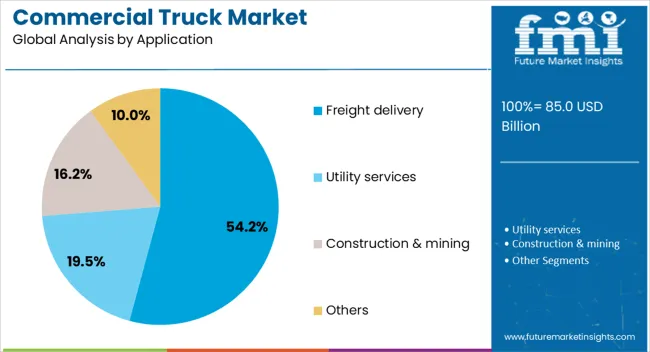
The freight delivery segment is anticipated to lead the application category with 54.20% of market revenue by 2025. This dominance is attributed to the surge in online retail, just-in-time supply chains, and logistics digitization, which have significantly expanded road freight volumes.
Commercial trucks are central to last mile and intercity deliveries, particularly in densely populated regions where flexibility and reliability are critical. Continued investment in smart fleet technologies, route optimization, and load efficiency has made commercial trucks indispensable in freight operations.
As global trade flows stabilize and warehousing expands, freight delivery is expected to remain the primary driver of demand within the commercial truck market.
The commercial truck market is experiencing steady growth driven by the increasing demand for transportation and logistics services globally. As e-commerce continues to expand, the need for reliable and efficient delivery systems is boosting the demand for commercial trucks. These trucks, used for transporting goods over long distances and across urban and rural areas, are essential in industries like construction, agriculture, and retail. Technological advancements, such as the development of electric trucks, improved fuel efficiency, and enhanced safety features, are also contributing to the market’s growth. With governments focusing on reducing emissions, the commercial truck market is witnessing a shift toward more eco-friendly solutions.
The growth of the commercial truck market is driven by the increasing need for efficient freight transportation and logistics services. With the expansion of global trade and the rise of e-commerce, the demand for fast and reliable delivery systems is higher than ever. Commercial trucks are essential for the transportation of goods, ranging from raw materials to finished products, and are vital in industries like retail, manufacturing, and construction. The growing need for faster, more reliable, and cost-effective logistics solutions in urban and rural areas is contributing to the expansion of the commercial truck market. Additionally, the ongoing infrastructure development across emerging markets is also boosting the demand for commercial trucks.
A key trend in the commercial truck market is the increasing integration of smart features and autonomous driving technologies. Fleet management systems, which utilize telematics and GPS for route optimization, vehicle tracking, and maintenance monitoring, are becoming more common, helping operators reduce costs and improve operational efficiency. Autonomous driving technology is another significant trend, with companies investing in self-driving trucks to improve safety, reduce human error, and cut down on labor costs. These smart and autonomous features not only improve the performance of commercial trucks but also enhance the overall driving experience, contributing to the market’s growth. As these technologies continue to advance, their integration into the commercial truck market will further revolutionize the transportation and logistics industries.
Despite the growth potential, the commercial truck market faces challenges, particularly with rising fuel prices and the need for regulatory compliance. Fluctuations in fuel prices significantly impact the operational costs of commercial trucks, affecting fleet operators' profitability. This challenge is compounded by the rising pressure from governments to comply with stricter emissions regulations, which require truck manufacturers to invest in new technologies and cleaner fuels. The high cost of upgrading fleets to meet these standards, along with the complexity of maintaining compliance across different regions, can be a barrier for small and medium-sized businesses. Overcoming these challenges will require further advancements in fuel-efficient and eco-friendly technologies, such as electric trucks and alternative fuels.
The commercial truck market offers significant opportunities with the growing adoption of electric trucks and technological innovations. As concerns over fuel emissions and environmental impact grow, the shift towards electric trucks is gaining momentum. Electric trucks offer lower operational costs, reduced emissions, and fewer maintenance requirements compared to traditional diesel-powered trucks, making them an attractive option for fleet operators. Furthermore, advancements in autonomous driving technologies and telematics are transforming the way commercial trucks operate, improving safety, fuel efficiency, and route optimization. As these technologies continue to evolve, the commercial truck market will expand, creating new opportunities for manufacturers, fleet operators, and technology developers in the sector.
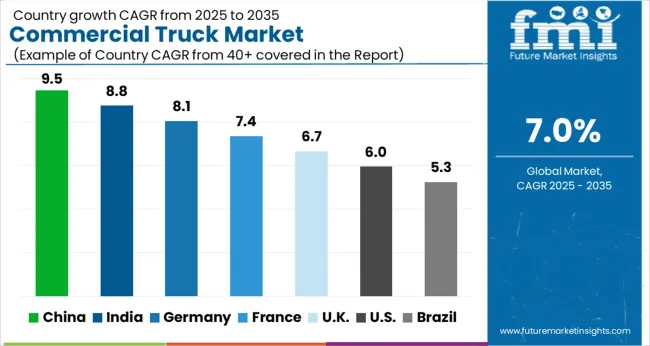
| Country | CAGR |
|---|---|
| China | 9.5% |
| India | 8.8% |
| Germany | 8.1% |
| France | 7.4% |
| UK | 6.7% |
| USA | 6.0% |
| Brazil | 5.3% |
Global commercial truck market demand is projected to rise at a 7.0% CAGR from 2025 to 2035.China leads at 9.5%, followed by India at 8.8%, and France at 7.4%, while the United Kingdom records 6.7% and the United States posts 6.0%. These rates translate to a growth premium of +35% for China, +25% for India, and +5% for France versus the baseline, while the United States and the United Kingdom show slower growth. Divergence reflects local catalysts: strong manufacturing, expanding infrastructure, and growing demand for freight and logistics solutions in China and India, while more mature markets like the United States and the United Kingdom experience moderate growth due to established infrastructure. The analysis includes over 40+ countries, with the leading markets detailed below.
The commercial truck market in China is expanding rapidly at a CAGR of 9.5%, driven by the country’s large-scale infrastructure development, urbanization, and booming logistics sector. As one of the largest producers of goods globally, China requires efficient transportation solutions, and the commercial truck market is a key contributor to supporting the increasing demand for freight transportation. The rise of e-commerce and the need for timely deliveries are further pushing the demand for commercial trucks. The government’s support for green energy and smart logistics solutions is also boosting the demand for more energy-efficient and technologically advanced trucks.
Sale of commercial truck in India is growing at a CAGR of 8.8%, driven by expanding infrastructure, growing demand for freight services, and the country’s rapidly increasing urbanization. The government’s focus on improving road networks and highways is enhancing transportation efficiency, thus contributing to the demand for commercial trucks. India’s growing industrial base, coupled with the rise in demand for retail and e-commerce, is further boosting the market. Additionally, the increase in logistics activities, especially in the agriculture and manufacturing sectors, continues to accelerate the need for heavy-duty and light-duty commercial trucks.
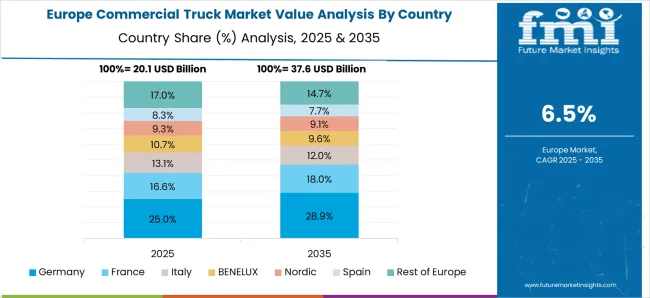
Demand for commercial truck in France is expanding at a CAGR of 7.4%, supported by increasing demand from the logistics, automotive, and industrial sectors. The country’s robust manufacturing base, combined with its strategic location in Europe, creates strong demand for commercial vehicles, particularly for freight and cargo transport. Government regulations encouraging the use of cleaner vehicles, as well as a focus on reducing emissions in the transport sector, are also influencing the demand for more fuel-efficient commercial trucks. The growth of e-commerce and online retail is contributing to the rise in demand for delivery vehicles.
The United Kingdom’s commercial truck market is growing at a CAGR of 6.7%, driven by rising demand in the transportation and logistics sectors. The UK’s strong road infrastructure, combined with increasing industrial output, creates a steady demand for commercial trucks. The shift towards electric and hybrid trucks, supported by government incentives for green transport solutions, is contributing to the market’s growth. Additionally, the growing need for last-mile delivery solutions in urban areas, driven by the e-commerce boom, is further boosting the demand for commercial trucks.

The USA commercial truck market is growing at a CAGR of 6.0%, with consistent demand from the transportation and freight sectors. While the market is mature, the growing demand for e-commerce deliveries and logistics services continues to support the need for commercial trucks. Advances in fuel efficiency, coupled with government regulations aimed at reducing emissions, are pushing the adoption of cleaner commercial truck solutions. Additionally, the rise of smart logistics, autonomous driving technology, and fleet management solutions is further enhancing the market’s outlook, particularly for heavy-duty trucks.
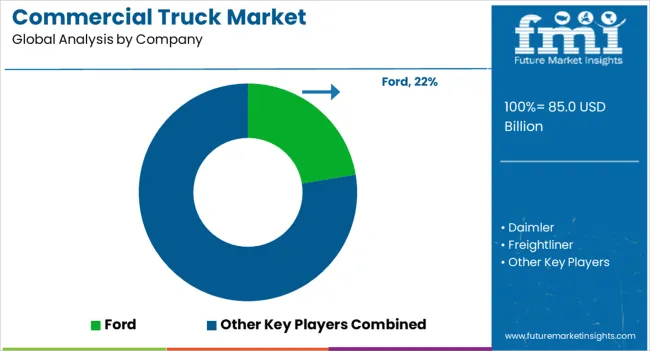
The commercial truck market is driven by key players offering robust, high-performance vehicles designed for various applications, including freight, logistics, construction, and long-haul transportation. Ford is a major player, providing durable and versatile commercial trucks like the Ford Super Duty, catering to both fleet and individual buyers, with an emphasis on performance and fuel efficiency.
Daimler, through its Freightliner brand, is one of the global leaders in the market, offering a wide range of heavy-duty trucks known for their advanced safety features, fuel efficiency, and high-performance capabilities. Navistar, with its International brand, provides a variety of commercial trucks, focusing on fuel-efficient, heavy-duty solutions that meet the growing demand for sustainable transportation options. Isuzu Motors is recognized for its reliable, cost-effective medium- and light-duty commercial trucks, popular in urban delivery and logistics applications. Kenworth, part of PACCAR, specializes in high-quality, heavy-duty trucks for long-haul applications, focusing on driver comfort and performance. Mack Trucks, known for its rugged and durable trucks, offers heavy-duty solutions that cater to the construction, long-haul, and vocational segments, emphasizing power and reliability. MAN is a significant player, offering advanced commercial trucks with a focus on fuel efficiency, safety, and high load capacities. Peterbilt, also part of PACCAR, offers premium trucks with strong brand recognition in the long-haul and vocational sectors, focusing on innovation and customization. Scania AB provides premium commercial vehicles known for their efficiency, sustainability, and high performance, particularly in the heavy-duty segment. Volvo Trucks offers a wide range of commercial trucks, renowned for their safety features, fuel efficiency, and sustainability-focused innovations.
| Item | Value |
|---|---|
| Quantitative Units | USD 85.0 Billion |
| Fuel | Diesel, Natural gas, and Hybrid electric |
| Class | Class 1, Class 2, Class 3, Class 4, Class 5, Class 6, Class 7, and Class 8 |
| Application | Freight delivery, Utility services, Construction & mining, and Others |
| Ownership | Fleet operator and Owner operator |
| Regions Covered | North America, Europe, Asia-Pacific, Latin America, Middle East & Africa |
| Country Covered | United States, Canada, Germany, France, United Kingdom, China, Japan, India, Brazil, South Africa |
| Key Companies Profiled | Ford, Daimler, Freightliner, Navistar, Isuzu Motors, Kenworth, Mack Trucks, MAN, Peterbilt, Scania AB, and Volvo Trucks |
| Additional Attributes | Dollar sales by product type (heavy-duty trucks, medium-duty trucks, light-duty trucks) and end-use segments (freight transportation, construction, logistics, vocational use). Demand dynamics are driven by the growing need for efficient and sustainable transportation solutions, increasing e-commerce, and investments in infrastructure development. Regional trends show strong growth in North America, Europe, and Asia-Pacific, with advancements in fuel efficiency, safety regulations, and the rising adoption of electric and hybrid truck technologies contributing to market expansion. |
The global commercial truck market is estimated to be valued at USD 85.0 billion in 2025.
The market size for the commercial truck market is projected to reach USD 167.2 billion by 2035.
The commercial truck market is expected to grow at a 7.0% CAGR between 2025 and 2035.
The key product types in commercial truck market are diesel, _freight delivery, _utility services, _construction & mining, _others, natural gas, _freight delivery, _utility services, _construction & mining, _others, hybrid electric, _freight delivery, _utility services, _construction & mining, _others, _others, _freight delivery, _utility services, _construction & mining and _others.
In terms of class, class 1 segment to command 24.5% share in the commercial truck market in 2025.






Full Research Suite comprises of:
Market outlook & trends analysis
Interviews & case studies
Strategic recommendations
Vendor profiles & capabilities analysis
5-year forecasts
8 regions and 60+ country-level data splits
Market segment data splits
12 months of continuous data updates
DELIVERED AS:
PDF EXCEL ONLINE
Commercial High-Speed Oven Market Size and Share Forecast Outlook 2025 to 2035
Commercial Turboprop Aircrafts Market Size and Share Forecast Outlook 2025 to 2035
Commercial Vehicle Foundation Brakes Market Size and Share Forecast Outlook 2025 to 2035
Commercial Vehicle Brake Chambers Market Size and Share Forecast Outlook 2025 to 2035
Commercial Vehicles LED Bar Lights Market Size and Share Forecast Outlook 2025 to 2035
Commercial Vehicle AMT Transmission Market Size and Share Forecast Outlook 2025 to 2035
Commercial Greenhouse Market Size and Share Forecast Outlook 2025 to 2035
Commercial Vessel Market Size and Share Forecast Outlook 2025 to 2035
Commercial Slush Machine Market Size and Share Forecast Outlook 2025 to 2035
Commercial Medium Voltage Distribution Panel Market Size and Share Forecast Outlook 2025 to 2035
Commercial Earth Observation (CEO) Market Size and Share Forecast Outlook 2025 to 2035
Commercial Ozone Generator Market Size and Share Forecast Outlook 2025 to 2035
Commercial Gas-Fired Boiler Market Size and Share Forecast Outlook 2025 to 2035
Commercial Deep Fryer Parts & Accessories Market Size and Share Forecast Outlook 2025 to 2035
Commercial Gas Restaurant Ranges Market Size and Share Forecast Outlook 2025 to 2035
Commercial Heat Pump Market Size and Share Forecast Outlook 2025 to 2035
Commercial Countertop Ranges Market Size and Share Forecast Outlook 2025 to 2035
Commercial Electric Restaurant Ranges Market Size and Share Forecast Outlook 2025 to 2035
Commercial Distribution Panel Market Size and Share Forecast Outlook 2025 to 2035
Commercial Liquid-Tight Flexible Non-Metallic Conduit Market Size and Share Forecast Outlook 2025 to 2035

Thank you!
You will receive an email from our Business Development Manager. Please be sure to check your SPAM/JUNK folder too.
Chat With
MaRIA